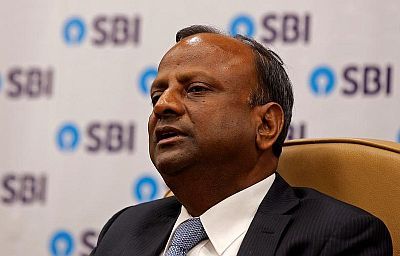 | « Back to article | Print this article |
'Mostly, the relief, if needed, would be for housing loans where a person has lost a job and is unable to pay his EMI or there has been a temporary salary cut.'

SBI Chairman Rajnish Kumar doesn't see any reason to fear a sudden rise in bad debt during the pandemic.
Legacy loans are well taken care of, the bank has enough capital, and the exposure to sectors affected by the COVID-19 stress is minuscule in relation to the balance sheet, Ranish Kumar tells Abhijit Lele, Vishal Chhabria and Anup Roy.
For the first time, we will have a restructuring of retail loans. Is that a challenge?
We are working on what our policy would be and to whom the relief should be extended.
But mostly, the relief, if needed, would be for housing loans where a person has lost a job and is unable to pay his EMI or there has been a temporary salary cut.
In the case of SBI, the housing loan book under moratorium is about Rs 32,000 crore.
But we believe most customers would start paying EMIs from September as the moratorium comes to an end.
But whoever needs relief should get it.
Critics say banks may not have enough time to prepare resolution for all under the latest restructuring scheme.
I don't think we have to wait for the RBI for such an exercise.
There are not many accounts in the corporate group of Rs 1,500 crore and above which would need to go to the committee because a lot of work has already happened under the June 7 framework.
There will be some modalities that the committee will suggest, but the ground work such as who would need restructuring, their projections, estimations, etc, can be done.
Do bankers have the ability to project the top line and the bottom line when companies ask for such resolution?
Future projection is the first thing that is considered in any proposal.
Of course, the COVID-19 scenario brings in a lot of uncertainty.
Nobody knows how long COVID-19 will continue and what the revival plan will be.
When you give credit or restructure, it is based on certain assumptions, and even the current exercise will have to return to those assumptions, particularly for the term loans.
The maximum one can postpone or restructure the instalments is for two years.
So whoever had to pay in five years will have to pay now in seven years.
Another criterion is that the account should be performing.
Whatever you have to do is within these two boundaries.
Do you need additional funds for all the restructuring exercise?
We already have Rs 20,000 crore (rs 200 billion) as our enabling provision.
We will need to raise money from the equity market only if there is a growth in assets, for any sort of provisions for bad loans.
For any risk capital, we have sufficient earnings. And we have the value sitting in our subsidiaries.
So, we are in no hurry as far as raising equity goes.
We will do our AT1 (additional tier 1), AT2 as per the plan.
Right now we are relying on our internal accrual routes.
The bigger challenge is on the retail side as almost half of the moratorium is due to these loans. Given the set of economy and different sectors, how feasible will it be to recover such loans?
Restructuring for retail has come for the first time.
I’m sure lenders will make their assessment of portfolio.
Moratorium by itself is not a pointer that everybody would apply or need restructuring.
 In the case of SBI, housing loans worth Rs 32,000 crore (Rs 320 billion) are under moratorium where zero or one installment has been paid.
In the case of SBI, housing loans worth Rs 32,000 crore (Rs 320 billion) are under moratorium where zero or one installment has been paid.
I believe, many of them will start paying from September as moratorium was available and they were preserving cash.
The loan to value for SBI in this segment is 60 per cent. The restructuring would be needed in cases where income was impacted.
That is not a large universe.
Thus, any fear of large scale restructuring is uncalled for.
The recent norms on current account are seen as beneficial for public sector banks.
Let us not view it as beneficial for either public sector bank or private bank.
This is meant to benefit the entire banking system.
This system of lenders not having a complete control over the cash flow was leading to a lot of indiscipline.
I doubt whether this type of freedom is permitted anywhere where you borrow from one bank and that bank does not have full control over the cash flow.
The only thing banks will have to ensure is that there are no difficulties on an operational basis to any bank.
Are you concerned about the NPA situation that is going to hit us after the pandemic, if it lingers on?
The scenarios are not uniform for every bank or every institution, it depends on the underwriting practices, or to which sectors they are exposed to, and what their level of risk diversification is.
When negative growth is expected, it is natural that stress in the system will go up.
It is a wait and watch situation for everyone.
In the last three years, most banks have done a lot of clean-up and provision coverage ratio are at an all-time high.
As for SBI, the provision coverage ratio (PCR) has improved from 61 to more than 86 per cent.
Legacy NPA today is 1.86 per cent, and it was 5 per cent plus.
What would be the bad debt impact for SBI?
Our legacy costs are very minimal. As an example, today, in the corporate book, SBI's net NPA is Rs 10,500 crore (Rs 105 billion).
Just one quarter's earnings are sufficient to make it zero.
The corporate book has no legacy credit cost left.
In our baseline scenario, not accounting for Covid, it is 1 per cent to 1.5 per cent of slippages.
Considering Covid, we believe in the worst case scenario this 1.5 per cent can become 2.5 per cent to 3 per cent.
Also, it has to be kept in consideration that in 2018, the slippage was Rs 1 trillion for SBI. At that time, our annual earnings were Rs 51,000 crore (Rs 510 billion).
Today, our earnings are touching Rs 70,000 crore (Rs 700 billion) plus, and the fresh slippages in normal circumstances would not exceed Rs 30,000 to Rs 35,000 crore (Rs 300 billion to Rs 350 billion).
Our exposure to the sectors impacted by COVID-19 is minuscule in relation to the size of the balance sheet.
We cannot lower the guard, but at the same time, we are very confident that we'll be able to manage this situation pretty well.
Do you expect any problem in signing the inter-creditor agreement (ICA) this time? It has been a problem area …
Speed is of essence in restructuring.
And that is where these steps by the RBI that everybody acts within 30 days will help.
In a situation like this when you want to restructure quickly, banks cannot take time forever towards decision making.
In ICA, there are always some differences, but we should be able to sort those out.
We will take a very holistic view and there are certain inbuilt penalties for not taking decision on time.
What is the trajectory of interest rates you are seeing and is there any room where you can tweak the rates further?
Not right now, and we are acting in tandem with signals coming from the RBI.
This time it is a pause, let's see what happens in the October monetary policy.
SBI ranks pretty high in many parameters, your subsidiaries are also very valuable. But if you exclude the value of SBI holding in the subsidiaries, the bank valuations are almost negligible.
When we work, our focus is on performance.
So sooner or later, the market participants or investors will realise the value.
Ultimately, investors have to gain confidence that they have to believe in what the management is saying.
They will believe when they see consistent performance.
I think the markets have already started seeing the value.
And we are very mindful of the fact that our minority shareholders, as well as the majority shareholder, should remain happy.